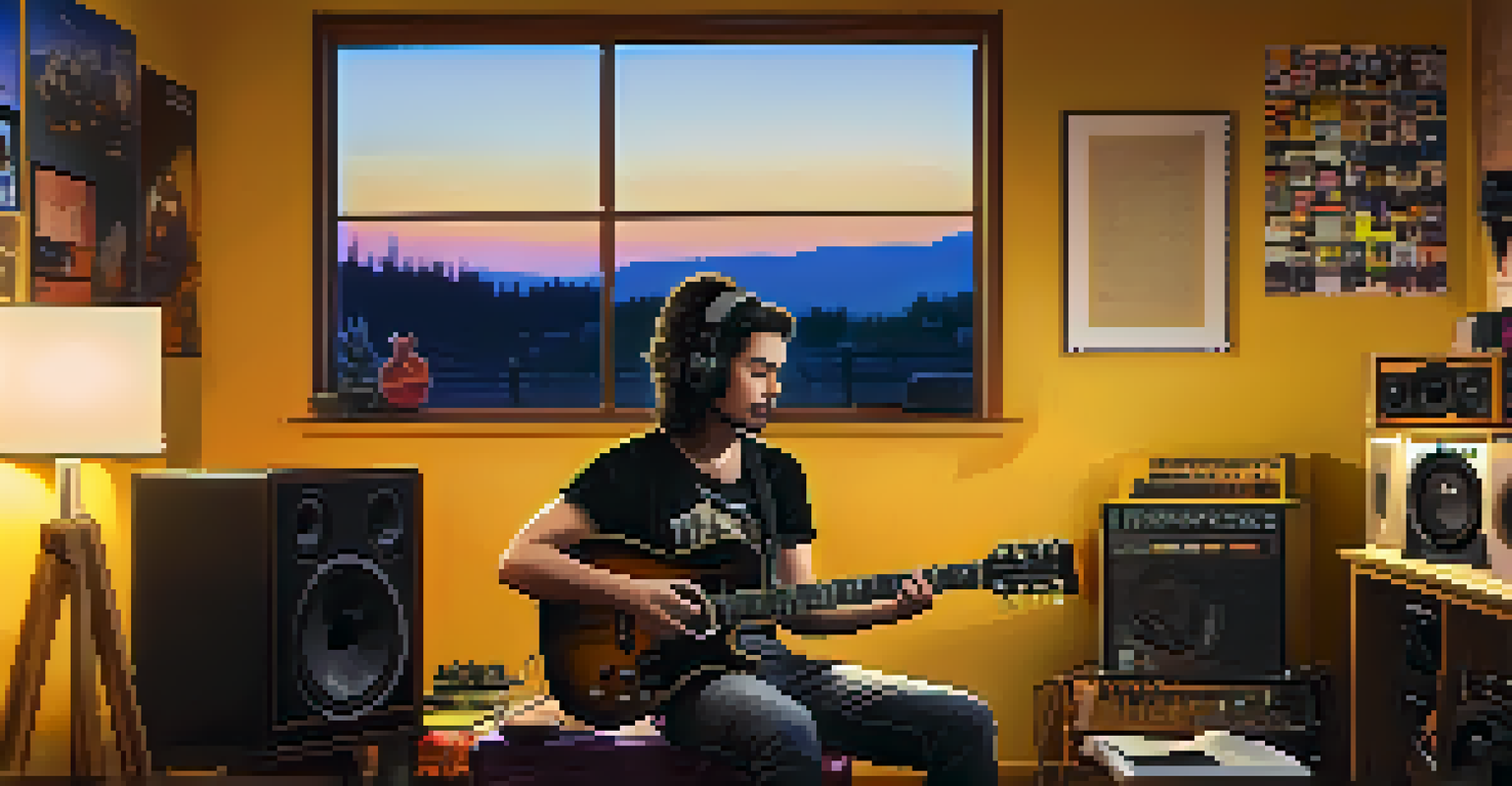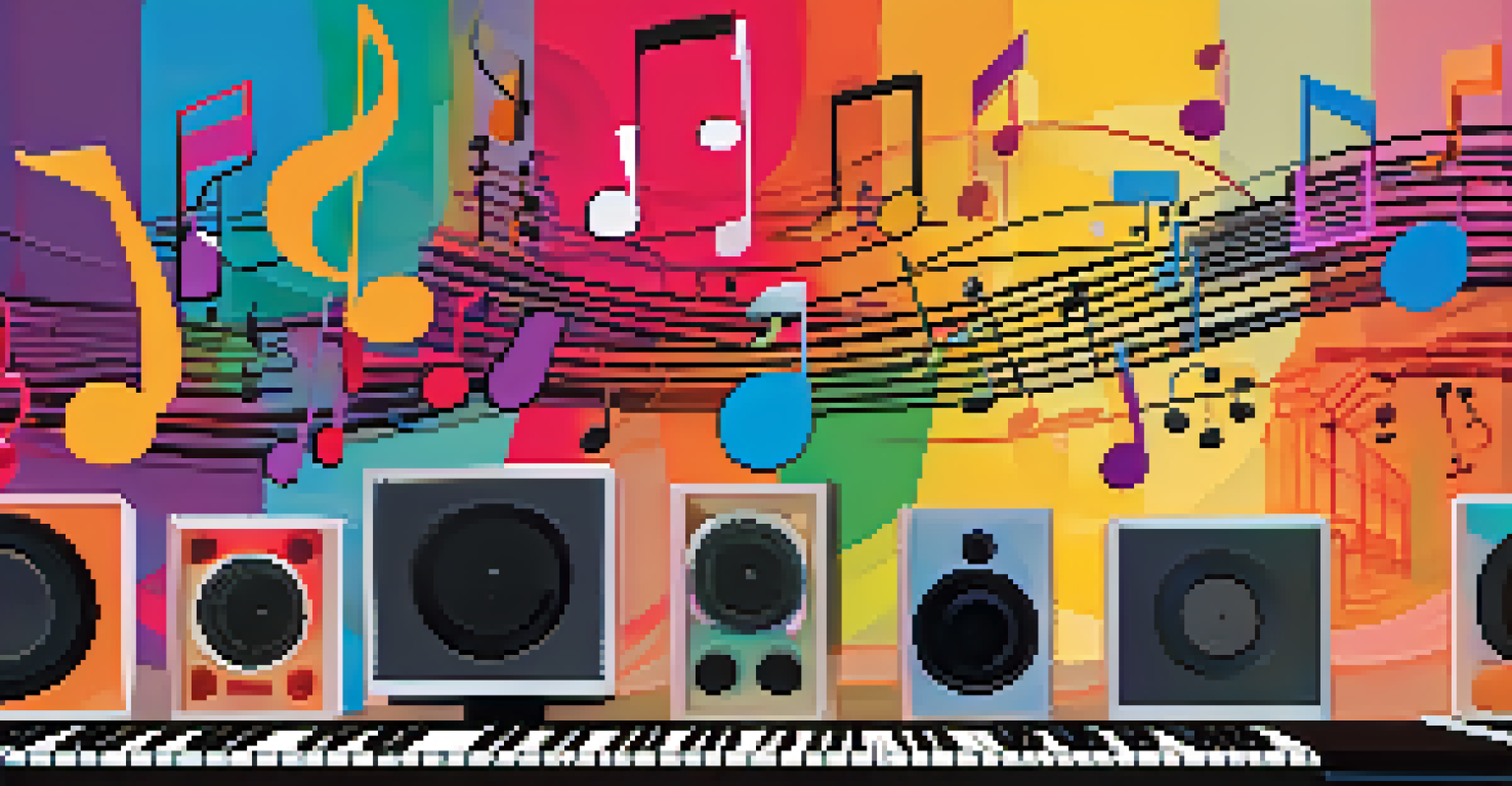Collaborative Music Creation: Guitarists on Digital Platforms

The Rise of Digital Collaboration in Music Creation
In recent years, digital platforms have revolutionized how musicians collaborate. Gone are the days when you needed to be in the same room to create music together. Now, guitarists can connect from all corners of the globe, sharing ideas and riffs through various online tools.
Music is the shorthand of emotion.
Platforms like Soundtrap and BandLab allow musicians to record, edit, and share their tracks seamlessly. This shift not only enhances creativity but also paves the way for unique musical fusions that might not have been possible otherwise. Imagine a guitarist in New York jamming with someone in Tokyo, creating a sound that blends their unique styles!
Moreover, these platforms often come with built-in tools and features that make collaboration easier, promoting a sense of community among musicians. With just a few clicks, guitarists can exchange feedback and inspire each other, fostering a vibrant creative environment.
Popular Platforms for Guitarists to Collaborate
There are several standout platforms that cater specifically to guitarists looking to collaborate. For example, platforms like Soundtrap and JamKazam have gained popularity for their user-friendly interfaces and collaborative features. These tools allow guitarists to lay down their tracks while others jump in with their parts in real-time.

Additionally, social media platforms like Instagram and TikTok have become hotbeds for musical collaboration. Guitarists can post their riffs and invite others to duet, creating a chain of creativity that showcases diverse talents. This accessible format allows musicians to build their networks and find collaborators easily.
Digital Platforms Redefine Collaboration
Musicians can now collaborate globally through platforms like Soundtrap and BandLab, enhancing creativity and fostering unique musical fusions.
Each platform offers unique features, from video capabilities to integrated virtual instruments, enabling guitarists to explore various musical styles and techniques. The diversity of tools available means that there's something for everyone, whether you're a seasoned pro or just starting out.
Overcoming Challenges in Online Collaboration
While digital collaboration presents exciting opportunities, it also comes with its own set of challenges. One major hurdle is the issue of latency, where a slight delay in audio can disrupt the flow of a jam session. Guitarists need to find ways to sync their playing to avoid frustration.
The beautiful thing about learning is that no one can take it away from you.
Another challenge is the varying skill levels and styles among collaborators. It can be tricky to ensure that everyone's input complements each other, especially when working with musicians from different genres. Open communication and flexibility are key to overcoming these differences and creating something harmonious.
Despite these challenges, many guitarists find that the benefits of collaboration outweigh the difficulties. By embracing technology and maintaining a positive attitude, musicians can create stunning pieces of art that reflect their collective talent and creativity.
The Creative Process: From Idea to Final Track
The process of collaborative music creation typically begins with a spark of inspiration. It might be a catchy riff, a lyrical idea, or even a specific genre that a group wants to explore. Guitarists often share these initial thoughts through digital platforms, setting the stage for further development.
Once the ideas are flowing, the real magic happens. Guitarists can build on each other's contributions, layering tracks and experimenting with different sounds. This back-and-forth process not only enhances the final product but also allows each musician to learn from one another and refine their skills.
Challenges of Online Music Creation
Despite advantages, online collaboration presents challenges such as latency and varying skill levels, requiring open communication to overcome.
Finally, the collaborative effort culminates in a polished track that reflects the distinct styles of all participants. The sense of accomplishment that comes from creating something together often strengthens the bonds between musicians, leading to more collaborations in the future.
Showcasing Collaborative Works: Sharing Your Music
Once the collaboration is complete, sharing the music with the world becomes the next exciting step. Many guitarists utilize platforms like YouTube, SoundCloud, and Spotify to showcase their collaborative works. These platforms not only allow musicians to reach a wider audience but also facilitate feedback from listeners.
Social media plays a crucial role in promoting collaborative projects. By sharing snippets of their work on platforms like Instagram or TikTok, musicians can generate buzz and engage with fans. This interaction often leads to increased visibility and opportunities for future collaborations.
Additionally, hosting live-streamed jam sessions or virtual concerts can bring the collaborative experience full circle. Guitarists can interact with their audience in real-time, providing a unique experience that highlights their teamwork and creativity.
Building a Community of Musicians Online
Digital platforms have not only enabled collaboration but have also fostered a sense of community among musicians. Guitarists can connect with like-minded individuals, share their journeys, and support one another in their musical endeavors. This camaraderie is especially vital for those who may feel isolated in their local music scenes.
Online forums, social media groups, and collaborative challenges encourage musicians to engage and share their experiences. Whether it’s discussing gear, techniques, or creative processes, these interactions help build a supportive network that benefits everyone involved.
Building an Inclusive Music Community
Digital spaces are creating supportive networks among musicians, allowing them to share experiences and collaborate across diverse backgrounds.
As guitarists continue to collaborate online, they create a rich tapestry of musical expression that reflects diverse backgrounds and styles. This growing community elevates the art of music creation, making it an inclusive and exciting space for all.
The Future of Collaborative Music Creation
As technology continues to evolve, the future of collaborative music creation looks incredibly promising. Emerging tools and platforms are constantly being developed, making it easier and more accessible for guitarists to work together. Innovations in virtual reality and artificial intelligence could soon transform how musicians interact and create.
Moreover, as the music industry recognizes the value of collaboration, we can expect to see more initiatives that promote joint projects among artists. This shift could lead to exciting cross-genre collaborations and the emergence of new musical trends.

Ultimately, the spirit of collaboration will continue to thrive as guitarists embrace the digital age. By harnessing the power of technology, musicians can break down barriers and create unforgettable music that resonates with audiences worldwide.